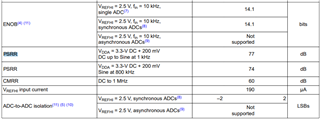Hi Team,
https://www.ti.com/lit/ds/symlink/tms320f28374d.pdf P104 8.10.1.2.2 ADC Characteristics (16-Bit Differential Mode)

How to measure PSRR of ADC module?
--
Thanks & Regards
Yale
This thread has been locked.
If you have a related question, please click the "Ask a related question" button in the top right corner. The newly created question will be automatically linked to this question.
Hi Team,
https://www.ti.com/lit/ds/symlink/tms320f28374d.pdf P104 8.10.1.2.2 ADC Characteristics (16-Bit Differential Mode)

How to measure PSRR of ADC module?
--
Thanks & Regards
Yale
Hello Yale,
The PSRR (Power Supply Rejection Ratio) measures the noise that propagates to the ADC by varying the power signal to inject noise:
Let me know if you have further questions.
Best regards,
Omer Amir
Hi Omer,
Thanks for your help!
So the PSRR of ADC module is the influence that power rail's noise takes to ADC conversion.
Could you please take a further explain for "DC up to Sine at 1 kHz"? What is the difference from "Sine at 800 kHz"?
Low frequency (1 kHz) and high frequency (1 MHz) noise signal with 200 mV is applied to the power rail
Where did the 1 MHz comes from?
Could you please take a further explain for "DC up to Sine at 1 kHz"? What is the difference from "Sine at 800 kHz"?
The difference is the performance; the DC to 1 kHz is the approximate flat attenuation and rolls off beyond a few hundreds of kHz, so we separate them out in the data sheet to emphasize this.
Where did the 1 MHz comes from?
1 kHz and 1 MHz are regions that represent the bode plot attenuation, and at the 1 MHz region noise attenuation starts to drop off.